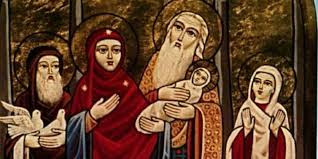Homily
for the Presentation of the Lord
Today’s Feast of the Presentation of the Lord is a
feast that reflects the one light of Christ from different angles and in
different ways. Historically the feast has been known by different names, each
stressing a different aspect of the same mystery: the mystery that God has chosen to dwell among us.
Forty days after the birth of Jesus, Mary and Joseph
traveled to Jerusalem to present him at the Temple. This was the first time
Jesus entered the temple that years later he would cleanse of merchants with
great zeal. The same temple where he would teach his disciples and challenge
the Pharisees. The same temple where Judas would receive thirty silver coins in
return for his betrayal.
As you heard in the Gospel, Mary and Joseph presented Jesus with grateful hearts and offered the sacrifice prescribed by the Law of Moses for the poor: two young pigeons. God fulfills the prophecy of Malachi when Simeon identifies the child as the awaited Messiah.
Simeon’s words at first are joyful and triumphant, the child is a light for revelation, the
glory of Israel, but then he turns to the Blessed Mother and his tone
becomes somber speaking of suffering and sacrifice: this child will be a contradiction and a sword will pierce your heart.
This feast invites us to celebrate with Simeon that
all prophecy has been fulfilled, while at the same time, it invites us to
remember that Jesus was born to die as a sacrifice for our sins. (Pause)
For centuries this feast was also known as the
Purification of the Virgin Mary, an event we also commemorate today.
When a Jewish person had direct contact with blood,
the person became unclean and he or she had to undergo religious rites to be
purified. An example of this
would be the Parable of the Good Samaritan where the priests did not help the
dying man for fear of touching blood and becoming impure. And of course when
women give birth, obviously they have contact with blood.
The Book of Leviticus prescribed that forty days after
giving birth a woman had to be ritually cleansed.
Today, forty days after Christmas Day, we commemorate
that the Blessed Mother faithfully followed the Law of Moses and was purified.
She who was conceived pure, without the stain of sin,
obediently offered the call for the sacrifice of two pigeons.
This feast invites us to ponder how the Blessed Mother
faithfully followed the Law of Moses and went to the Temple with her son to be purified
even though she did not need purification. An act of respect, obedience, and
humility. (pause)
As if this feast didn’t have enough layers, there is
one more.
Today’s feast has also been called Candlemass
throughout the centuries, a celebration of light (or candles).
Traditionally candles are blessed on this day,
followed by a procession in a darkened church, reminding us of Simeon’s words,
that the child born on Christmas day is the “light of the nations.”
This feast invites us to recognize Jesus as the light
that has come into the darkness to destroy sin and death. (Pause)
As you have heard, today, the one light of Christ is
reflected from different angles and in different ways.
The light that shines forth from the mystery that God
has chosen to dwell among us cannot be contained.
All is renewed, all is transformed, all things are
different because God has become man.
The joy of knowing the Messiah, the sorrow of
recognizing that he will be sacrificed, the blessedness of his mother and his
perpetual light that dispels the darkness; all converge on this feast forty
days after his birth.
The Church never ceases to proclaim the mystery that
God has become man. The Church never ceases to proclaim that our God who
created all things has emptied himself to become like one of his creatures.
As a candle offers itself as a sacrifice to give us
pure light, ceasing to exist as its wax melts away, slowly and selflessly dying
as it shines for others to have light, so too Our Savior is a light that offers
itself in sacrifice so that others may have life.
Candles always accompany the altar of sacrifice, burning
themselves to death as a sacrifice, reminding us of the One who died so that we
could have life.
Now understanding the Gospel message a little more
intimately, may we humbly and sincerely pray that the Lord help us to be
candles of his light, dying to ourselves, our pride, our self-centeredness, and
our greed, so that the light of Christ may shine ever so brightly within us and
onto the world. Amen



No comments:
Post a Comment